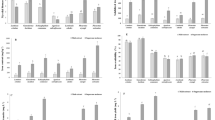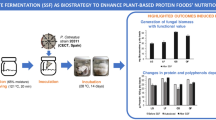Abstract
Iron deficiency anemia is a challenge to global public health, and the development of iron-enriched foods are an opportunity to reduce this problem. Lentinus crinitus is a basidiomycete with high metal bioaccumulation capacity that is consumed by Amazonian Indians. This study aimed to evaluate iron bioaccumulation in the mycelial biomass of L. crinitus cultivated in agroindustrial byproducts. First, the fungus grew in a liquid medium with iron addition from 0.116 (control) to 100 mg L−1. The addition of 90 mg L−1 iron to the culture medium resulted in 15.07 ± 1.44 dg kg−1 of iron mycelial bioaccumulation, a 9000-fold increase compared with the control. Then, the fungus grew in agroindustrial byproducts sugarcane (SCM) or soybean (SBM) molasses added with 90 mg L−1 iron and 0.9 mg L−1 manganese, a new element in the assay. The iron concentrations in the mycelial biomass cultivated in SCM or SBM were 20.78 ± 2.28 or 34.71 ± 4.31 dg kg−1, respectively, at 21 cultivation days. The cultivation time and the presence of iron and manganese in the culture media were important variables for iron bioaccumulation in the mycelial biomass. Our study evidenced that agroindustrial byproducts, mainly SCM, can be used to successfully produce mycelial biomass enriched with iron - as an alternative functional food - to add value to the food production chain. Also, the iron-enriched biomass can be an alternative for non-living animal protein supply.
Graphical abstract




Similar content being viewed by others
References
Shubham, K., Anukiruthika, T., Dutta, S., Kashyap, A.V., Moses, J.A., Anandharamakrishnan, C.: Iron deficiency anemia: a comprehensive review on iron absorption, bioavailability and emerging food fortification approaches. Trends Food Sci. Technol. 99, 58–75 (2020). https://doi.org/10.1016/j.tifs.2020.02.021
Lopez, A., Cacoub, P., Macdougall, I.C., Peyrin-Biroulet, L.: Iron deficiency anaemia. Lancet. 387, 907–916 (2016). https://doi.org/10.1016/S0140-6736(15)60865-0
WHO – World Health Organization: The global prevalence of anemia in 2011. WHO, Geneva. https://apps.who.int/iris/bitstream/handle/10665/177094/9789241564960_eng.pdf?sequence=1 (2015) Accessed 10 Mar 2020
WHO – World Health Organization, Department of Nutrition for Health and Development. Global nutrition targets 2025: anemia policy brief. WHO/NMH/NHD, Geneve. file:///C:/Users/Usuario/Downloads/WHO_NMH_NHD_14.4_eng.pdf. (2014). Accessed 10 Mar 2020
Manoguerra, A.S., Erdman, A.R., Booze, L.L., Christianson, G., Wax, P.M., Scharman, E.J., Woolf, A.D., Chyka, P.A., Keyes, D.C., Olson, K.R., Caravati, E.M., Troutman, W.G.: Iron ingestion: an evidence-based consensus guideline for out-of-hospital management. Clin. Toxicol. 43, 553–570 (2005). https://doi.org/10.1081/CLT-200068842
Murray-Kolb, L.E., Beard, J.L.: In: Coates, P.M., Betz, J.M. (eds.) Encyclopedia of Dietary Supplements, pp. 432–438. London/New York, Informa Healthcare (2010)
IOM – Institute of Medicine. Dietary Reference Intakes: the essential guide to nutrient requirements. National Academic, Washington DC: The National Academies Press. https://doi.org/10.17226/11537 (2006). Accessed 23 Feb 2020
Mshandete, A.M., Mgonia, J.R.: Submerged liquid fermentation of some Tanzanian Basidiomycetes for the production of mycelial biomass, exopolysaccharides and mycelium protein using waste peel media. ARPN J. Agric. Biol. Sci. 4, 1–13 (2009)
Almeida, S.M., Umeo, S.H., Marcante, R.C., Yokota, M.E., Valle, J.S., Dragunski, D.C., Colauto, N.B., Linde, G.A.: Iron bioaccumulation in mycelium of Pleurotus ostreatus. Brazilian J. Microbiol. 46, 195–200 (2015). https://doi.org/10.1590/S1517-838246120130695
Meniqueti, A.B., Ruiz, S.P., Faria, M.G.I., Valle, J.S., Gonçalves Jr., A.C., Dragunski, D.C., Colauto, N.B., Linde, G.A.: Iron-enriched mycelia of edible and medicinal basidiomycetes. Environ. Technol. (2020). https://doi.org/10.1080/09593330.2020.1824023
Umeo, S.H., Faria, M.G.I., Vilande, S.S.S., Dragunski, D.C., Do Valle, J.S., Colauto, N.B., Linde, G.A.: Iron and zinc mycelial bioaccumulation in Agaricus subrufescens strains. Semin. Agrar. 40, 2513–2522 (2019). https://doi.org/10.5433/1679-0359.2019v40n6p2513
Faria, M.G.I., Do Valle, J.S., Lopes, A.D., Gonçalves, A.C., Dragunski, D.C., Colauto, N.B., Linde, G.A.: Bioaccumulation of lithium (Li2CO3) in mycelia of the culinary-medicinal oyster mushroom, Pleurotus ostreatus (agaricomycetes). Int. J. Med. Mushrooms. 20, 901–907 (2018). https://doi.org/10.1615/IntJMedMushrooms.2018027343
Marcante, R.D.C., Meniquetti, A., Pascotto, C.R., Gazim, Z.C., Magalhães, H.M., Colauto, N.B., Linde, G.A.: Bioacumulação de zinco em micélio de Agaricus subrufescens. Arq. Ciên. Vet. Zool. UNIPAR. 17, 249–252 (2015). https://doi.org/10.25110/arqvet.v17i4.2014.5025
Silva, G.T., Gibertoni, T.B.: Aphyllophorales (Basidiomycota) em áreas urbanas da Região Metropolitana do Recife, PE. Brasil. Hoehnea. 33, 533–543 (2006)
Vargas-isla, R., Ishikawa, N.K., Py-daniel, V.: Contribuições etnomicológicas dos povos indígenas da Amazônia. Biota Amazônia. 3, 58–65 (2013)
Abraham, W.R., Abate, D.: Antimicrobial metabolites from Lentinus crinitus. J. Antibiot. 47, 1348–1350 (1994). https://doi.org/10.7164/antibiotics.47.1348
Tavares, M.F., Avelino, K.V., Araújo, N.L., Marim, R.A., Linde, G.A., Colauto, N.B., do Valle, J.S.: Decolorization of azo and anthraquinone dyes by crude laccase produced by Lentinus crinitus in solid state cultivation. Brazilian J. Microbiol. 51, 99–106 (2020). https://doi.org/10.1007/s42770-019-00189-w
Caroline, E., Brito, D.M., Rodrigo, I., Braga, S., Francisca, M., Teixeira, S., Salomão, I.I., Martim, R.: Production and partial characterization of aspartic proteases synthesized by Lentinus crinitus (L.) Fr. 1825 DPUA 1693 (Polyporaceae). Bol. Mus. Para. Emílio Goeldi. Cienc. Nat. 14, 463–472 (2019)
Faria, M.G.I., Avelino, K.V., do Valle, J.S., da Silva, G.J., Gonçalves, A.C., Dragunski, D.C., Colauto, N.B., Linde, G.A.: Lithium bioaccumulation in Lentinus crinitus mycelial biomass as a potential functional food. Chemosphere. 235, 538–542 (2019). https://doi.org/10.1016/j.chemosphere.2019.06.218
Scheid, S.C., Faria, M.G.I., Velasquez, L.G., Valle, J.S., Gonçalves Jr., A.C., Dragunski, D.C., Colauto, N.B., Linde, G.A.: Iron biofortification and availability in the mycelial biomass of edible and medicinal basidiomycetes cultivated in sugarcane molasses. Sci. Rep. 10, 12875 (2020). https://doi.org/10.1038/s41598-020-69699-0
Umeo, S.H., Souza, G.P.N., Rapachi, P.M., Garcia, D.M., Paccola-Meirelles, L.D., Valle, J.S., Colauto, N.B., Linde, G.A.: Screening of basidiomycetes in submerged cultivation based on antioxidant activity. Genet. Mol. Res. 14, 9907–9914 (2015). https://doi.org/10.4238/2015.August.19.25
Ravindran, R., Hassan, S.S., Williams, G.A., Jaiswal, A.K.: A review on bioconversion of agro-industrial wastes to industrially important enzymes. Bioengineering. 5, 1–20 (2018). https://doi.org/10.3390/bioengineering5040093
Sadh, P.K., Duhan, S., Duhan, J.S.: Agro-industrial wastes and their utilization using solid state fermentation: a review. Bioresour. Bioprocess. 5, 1–15 (2018). https://doi.org/10.1186/s40643-017-0187-z
CONAB - Companhia Nacional de Abastecimento. 2019. Acompanhamento da safra brasileira de cana-de-açúcar. CONAB, Brasília. Available at: https://www.conab.gov.br/info-agro/safras/cana/boletim-da-safra-de-cana-de-acucar (2019) Accessed 10 Feb 2020
CONAB - Companhia Nacional de Abastecimento. 2019. Acompanhamento da safra brasileira de grãos. Available at: https://www.conab.gov.br/info-agro/safras/graos/boletim-da-safra-de-graos (2019) Accessed 10 Feb 2020
Rein, P.: Cane Sugar Engineering, 768 p. VERLAG, Berlin (2007)
Dong, J., Du, Y., Zhou, Y., Yang, S.T.: Butanol production from soybean hull and soy molasses by acetone-butanol-ethanol fermentation. ACS Symp. Ser. 1178, 25–41 (2014). https://doi.org/10.1021/bk-2014-1178.ch002
Siqueira, P.F., Karp, S.G., Carvalho, J.C., Sturm, W., Rodríguez-León, J.A., Tholozan, J.L., Singhania, R.R., Pandey, A., Soccol, C.R.: Production of bio-ethanol from soybean molasses by Saccharomyces cerevisiae at laboratory, pilot and industrial scales. Bioresour. Technol. 99, 8156–8163 (2008). https://doi.org/10.1016/j.biortech.2008.03.037
De Pretto, C., de Giordano, R., Tardioli, P.W., Costa, C.B.B.: Possibilities for producing energy, fuels, and chemicals from soybean: a biorefinery concept. Waste Biomass Valorization. 9, 1703–1730 (2018). https://doi.org/10.1007/s12649-017-9956-3
Philpott, C.C.: Iron uptake in fungi: a system for every source. Biochim. Biophys. Acta, Mol. Cell Res. 1763, 636–645 (2006). https://doi.org/10.1016/j.bbamcr.2006.05.008
Ines, M., Amel, K., Yousra, T., Neila, S., Imen, D., Marie, M.J., Abdennasseur, H.: Effect of dose-response of zinc and manganese on siderophores production. Am. J. Environ. Sci. 8, 143–151 (2012). https://doi.org/10.3844/ajessp.2012.143.151
Zaghi Jr., L.L.Z., Lopes, A.D., Cordeiro, F.A., Colla, I.M., Bertéli, M.B.D., Valle, J.S., do Linde, G.A., Colauto, N.B.: Cryopreservation at −75 °C of Agaricus subrufescens on wheat grains with sucrose. Brazilian J. Microbiol. 49, 370–377 (2018). https://doi.org/10.1016/j.bjm.2017.08.003
Ciabotti, S.: Aspectos químico, físico-químico e sensorial de extratos de soja e tofus obtidos dos cultivares de soja convencional e livre de lipoxigenase. Dissertação (Mestrado em Ciência de Alimentos) - Universidade Federal de Minas Gerais. 135 (2004)
AOAC - Official Methods of Analysis. Association of Official Analytical Chemists, 15th ed, Vol 2, Inc, Washington DC, 1990
Kosman, D.J.: Molecular mechanisms of iron uptake in fungi. Mol. Microbiol. 47, 1185–1197 (2003). https://doi.org/10.1046/j.1365-2958.2003.03368.x
Gadd, G.M.: Geomycology: biogeochemical transformations of rocks, minerals, metals and radionuclides by fungi, bioweathering and bioremediation. Mycol. Res. 111, 3–49 (2007). https://doi.org/10.1016/j.mycres.2006.12.001
Ogidi, O.C., Nunes, M.D., Oyetayo, V.O., Akinyele, B.J., Kasuya, M.C.M.: Mycelial growth, biomass production and Iron uptake by mushrooms of Pleurotus species cultivated on Urochloa decumbens (Stapf) R. D. Webster. J. Food Res. 5, 13 (2016). https://doi.org/10.5539/jfr.v5n3p13
Mleczek, M., Siwulski, M., Budka, A., Mleczek, P., Budzyńska, S., Szostek, M., Kuczyńska-Kippen, N., Kalač, P., Niedzielski, P., Gąsecka, M., Goliński, P., Magdziak, Z., RzymskI, P.: Toxicological risks and nutritional value of wild edible mushroom species -a half-century monitoring study. Chemosphere. 263, 128095 (2021). https://doi.org/10.1016/j.chemosphere.2020.128095
Saha, R., Saha, N., Donofrio, R.S., Bestervelt, L.L.: Microbial siderophores: a mini review. J. Basic Microbiol. 53, 303–317 (2013). https://doi.org/10.1002/jobm.201100552
Protchenko, O., Ferea, T., Rashford, J., Tiedeman, J., Brown, P.O., Botstein, D., Philpott, C.C.: Three Cell Wall Mannoproteins facilitate the uptake of Iron in Saccharomyces cerevisiae. J. Biol. Chem. 276, 49244–49250 (2001). https://doi.org/10.1074/jbc.M109220200
Comensoli, L., Bindschedler, S., Junier, P., Joseph, E.: Iron and fungal physiology: a review of biotechnological opportunities. Elsevier Ltd. (2017)
Braud, A., Hannauer, M., Mislin, G.L.A., Schalk, I.J.: The Pseudomonas aeruginosa pyochelin-iron uptake pathway and its metal specificity. J. Bacteriol. 191, 3517–3525 (2009). https://doi.org/10.1128/JB.00010-09
Damodaran, D., Vidya Shetty, K., Raj Mohan, B.: Uptake of certain heavy metals from contaminated soil by mushroom-Galerina vittiformis. Ecotoxicol. Environ. Saf. 104, 414–422 (2014). https://doi.org/10.1016/j.ecoenv.2013.10.033
Yokota, M.E., Frison, P.S., Marcante, R.C., Jorge, L.F., Valle, J.S., Dragunski, D.C., Colauto, N.B., Linde, G.A.: Iron translocation in Pleurotus ostreatus basidiocarps: production, bioavailability, and antioxidant activity. Genet. Mol. Res. 15, 1–10 (2016). https://doi.org/10.4238/gmr.15017888
Ben-Arye, T., Levenberg, S.: Tissue engineering for clean meat production. Front. Sustain. Food Syst. 3, 46 (2019). https://doi.org/10.3389/fsufs.2019.00046
Acknowledgements
The authors thank Paranaense University, West Paraná State University, Fundação Araucária, Conselho Nacional de Desenvolvimento Científico e Tecnológico (CNPq), and Coordenação de Aperfeiçoamento de Pessoal de Nível Superior - Brazil (CAPES).
Funding
This study was funded by Paranaense University, Fundação Araucária, Conselho Nacional de Desenvolvimento Científico e Tecnológico (CNPq), and Coordenação de Aperfeiçoamento de Pessoal de Nível Superior - Brazil (CAPES) -finance code 001- for the financial support and scholarships.
Author information
Authors and Affiliations
Contributions
ABM: Execution, analysis, investigation, writing of the draft. SPR: writing: reviewing and editing. MGIF: validation, writing: reviewing and editing. JSdV: conceptualization, validation, writing: reviewing and editing. ACGJr.: analysis, writing, critical reviewing, and editing. DCD: analysis, writing, critical reviewing, and editing. NBC: project administration, supervision, conceptualization, final writing: reviewing and editing. GAL: project administration, supervision, conceptualization, writing: critical reviewing and editing.
Corresponding author
Ethics declarations
Conflict of interest
The authors declare that there are no conflicts of interest.
Additional information
Publisher's Note
Springer Nature remains neutral with regard to jurisdictional claims in published maps and institutional affiliations.
Rights and permissions
About this article
Cite this article
Meniqueti, A.B., Ruiz, S.P., Faria, M.G.I. et al. Iron Bioaccumulation in Lentinus crinitus Mycelia Cultivated in Agroindustrial Byproducts. Waste Biomass Valor 12, 4965–4974 (2021). https://doi.org/10.1007/s12649-021-01353-w
Received:
Accepted:
Published:
Issue Date:
DOI: https://doi.org/10.1007/s12649-021-01353-w




